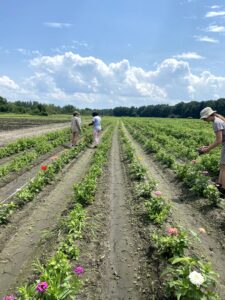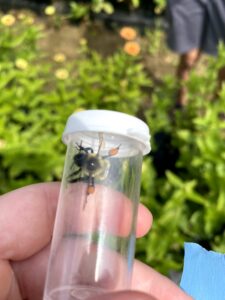Progress report for LNE21-424R
Project Information
Farmers, landscapers, conservation land managers, government and the public are all invested in providing floral resources to promote pollinator abundance, diversity and health. Pollen and nectar from certain flowers can reduce pollinator infection by detrimental pathogens, but this has been examined for only a few plant species and almost entirely in laboratory settings. The Adler lab recently discovered that sunflower pollen dramatically and consistently reduced a common detrimental gut pathogen of bumble bees in the lab, and that farms with more sunflower had bumble bees with reduced infections. If pollen from other flowers in the sunflower family (Asteraceae) similarly reduces infections in bumble bees, promoting the planting of Asteraceae cut flowers could be an avenue for farmers, landscapers, horticultural growers and land managers to improve bee health while providing a source of income. We will test this hypothesis using a two-pronged approach. We will work with growers at three ‘cut flower’ farms (at least 3/4 acre of cut flowers from our target species) and compare with 3 ‘control’ farms (1/10 acre cut flowers or less). We will deploy honey bee hives with pollen traps at the cut flower farms to collect pollen that we will sort, identify to species using DNA barcoding, and then test in the laboratory to determine effects of each cut flower species on pathogen infection. By testing the pollen of many species in the Asteraceae we will greatly expand our understanding of which pollen has medicinal benefits, may clarify underlying mechanisms, and will be able to make recommendations to stakeholders about species that promote bumble bee health. In addition, we will sample bumble bees twice from each cut flower and control farm (all will have honey bee hives to avoid confounding effects) and assess pathogen infections to determine whether cut flower plantings on farms reduce bee pathogens, as we found for sunflower. Stakeholders have shown overwhelming enthusiasm for this research, with over 97% of 2378 survey respondents saying that if we found specific flowers that reduce bee disease, they were ‘highly’ or ‘very highly’ likely to recommend or use these flowers in their farm/industry/garden. We have consulted with farmers on study design, cut flower selection and potential obstacles during proposal preparation, and will engage with farmers who host the cut flower and control sites. We will solicit input on study design and results via our advisory committee, and disseminate results widely via websites, listservs, fact sheets, our Research Buzz newletter, Vegetable Notes, Hort Notes, and presentations at stakeholder meetings. Taken together, this research will provide insights into how specific flowers may mediate pollinator health, and provide novel opportunities for low-input, non-chemical management practices that stakeholders can use to manage pollinator health and maintain sustainable agroecosystems.
Our goal is to evaluate whether pollen from cut flowers in the sunflower family (Asteraceae) can reduce disease in bumble bees, based on our discovery of this effect in sunflower pollen. We will collect a diversity of pollen from farms growing Asteraceae cut flowers to test its effects on bee pathogens in lab trials, and will collect bumble bees at ‘cut flower’ and ‘control’ farms to assess impacts of cut flowers on wild bees. Our work is novel for innovating sustainable, low-input approaches to manage pollinator health by growing specific crops whose pollen could reduce pollinator pathogens while providing income.
Pollinator decline is attributed to many factors, including pathogens and lack of food resources. Such declines can have consequences for food security, with lack of pollination limiting yield in several major US crops. Many farms are planting flowering strips to promote healthy and diverse pollinator communities and increase pollination. However, these floral resources could increase or decrease pathogen infection, depending on their relative roles in facilitating disease spread versus providing medicinal benefits.
In western Massachusetts many small and large farms grow cut flowers as a primary crop, a small part of a diverse planting plan, or to host weddings or agro-tourism. Many of these cut flowers are in the sunflower family (Asteraceae). My lab discovered that pollen from many sunflower varieties as well as goldenrod (also in the Asteraceae), all dramatically reduced common eastern bumble bee (Bombus impatiens) infection by Crithidia bombi. This common gut pathogen ('Crithidia' hereafter) can reduce bumble bee queen colony-founding success and colony size. Because many Asteraceae flower in late summer when daughter queens emerge and forage before overwintering, impacts on queen health are particularly important.
Our research will fill two major gaps by assessing whether (a) pollen from several cut flower species reduces pollinator infection in the lab and (b) floral plantings can reduce bee infection on farms. This work would have broad implications for the use of cut flowers in agroecoystems, the landscape industry, and designing pollinator habitat.
If we find evidence that pollen from Asteraceae cut flowers reduces bee pathogens in the lab and on farms, this could lead to changes in practice for several stakeholder groups. In our previous farm research, farms growing cut flowers averaged 29-35% of blooms from Asteraceae cut flower species (other than sunflower), indicating strong interest in our species but also room to increase investment. I requested input and assistance from Tawny Simisky, Sue Scheufele and Jason Lanier (all UMass Extension) to develop an informational survey to assess interest in our novel research approach. The survey was shared by these UMass Extension professionals to listservs reaching vegetable farmers, landscapers, turf managers, arborists, nurseries, garden centers, and greenhouse producers. We received 2384 responses; over 95% (2260 respondents) described themselves as ‘highly’ or ‘very highly’ interested in using flowering plants to improve pollinator health in their business/land ownership. Responses were resoundingly positive in terms of both number of individuals who participated and their overwhelming enthusiasm for the applications of our research, and clearly demonstrate strong enthusiasm for our novel approach.
Research
We conducted the on-farm study as described during summer 2021. We included the 3 'cut flower' and 3 'control' farms stated in our original proposal. We exceeded our proposal goals, collecting bumble bees and measuring floral resources three times per farm instead of twice as proposed. We also expanded the scope of the original study by collecting all the common bumble bees at the farms, including Bombus vagans, bimaculatus and grisecollis, as well as B. impatiens as originally proposed. We ultimately collected data from 687 bumble bees, of which 600 were B. impatiens and the rest were relatively evenly spread between the other three species. Due to the low sample size we will only be able to conduct statistical analyses for Bombus impatiens. Because we saw little relationship between cut flower abundance and infection at the first visit, for the second and third visits we also assessed bumble bee visitation to cut flowers, in case the lack of relationship was due to failure to visit these species.
We also collected pollen from the three cut flower farms, as described in our proposal, and spent fall 2021 doing a preliminary sorting to ascertain which colors of pollen were Asteraceae (had spines) in each collection. Due to COVID-related and other logistical delays, the machine to sort the pollen automatically by color is still not yet operational; we will send pollen for DNA barcoding and conduct the bioassays to determine effect on Crithidia infe ction as s
ction as s oon as the sorting is accomplished.
oon as the sorting is accomplished.
We spent fall 2021 (1) measuring the marginal cell length from the field-collected bees as an estimate of body size, which often correlates with infection intensity, and (2) entering data; the floral resource data set was large and this took quite a bit of time. Data analysis took place during spring and fall of 2022, and we have written a manuscript draft based on these results.
We requested a final no-cost extension to allow us until Nov 2024 to complete project objectives. We spent fall 2023 resigning ourselves to the prospect that the pollen sorter would not be functioning in time, and began to hand-sort pollen, led by a graduate student with the help of two undergraduate volunteers. It was laborious and slow. I am happy to report that my collaborator now gives a Feb 19, 2024 target date to have the pollen sorter functional. We hope therefore to sort pollen in late February and then conduct as many bioassays as possible this spring, and complete any that remain in the fall. We also found another potential source of pollen from some cut flowers, including Dahlias, that may be able to supplement our options in late summer to allow us to complete the bioassays before the grant's end date.
Because the farm results are largely negative, we plan to publish the lab bioassays and farm results in a single manuscript after the bioassays are complete.
We analyzed Crithidia infection (prevalence and intensity) from the field-collected Bombus impatiens. Bombus impatiens was an order of magnitude more common than any other bee species. Bumble bee abundance was highest at the farm that planted the most Asteraceae cut flowers. We found no statistically significant effect, or even a trend, for Asteraceae cut flowers to predict Crithidia infection prevalence or infection intensity across sites. Surprisingly, we found that larger bees had higher intensity infections; this is contrary to much of our previous work that found higher intensity infections in smaller bees. We also found that infection decreased over the season, regardless of farm or cut flower abundance.
In our preliminary results, we found that bumble bees visited several of the cut flower species, although visitation was highest to the Joe-Pye weed (Eutrochium) growing in the field margins and to cup plant (Silphium). Of the cut flowers, we saw highest visitation to cosmos, dahlias and Echinacea and slightly lower visitation to zinnias and ageratum; we have not compared these patterns statistically yet.
Education & Outreach Activities and Participation Summary
Educational activities:
Participation Summary:
Because our results found no relationship between cut flower abundance and bumble bee disease, we have not broadly disseminated them at this point. However, we did participate in the annual South Deerfield Farm day in 2021, which I estimate was attended by 30 farmers and 10 extension educators, and I discussed the hypotheses and goals of this project. Although I participated again in summers 2022 and 2023, our presentation focused on other research.
I trained 3 undergraduates and 2 graduate students who conducted the field work with me in summer 2021; an additional undergraduate researcher helped sort all the pollen in fall 2021, and two more helped hand-sort in fall 2023. This may not be what is meant by an 'educational activity,' but I strongly believe in the power of these experiences to train a new generation of potential agricultural researchers.
I ran our first Advisory Board meeting in April 2022 to describe our project context and get feedback on how to make it most effective. It was attended by two extension educators and three farmers (the members of the Advisory Board). Our second meeting happened in March 2023 to report on results so far. We also conducted our research on 6 farm fields (run by 5 farms) and discussed the premise with all of the participating farmers.
I am gave a research talk for UVM extension on Feb 17 2022, and discussed this project amongst others.
Data analysis and writing is largely complete for a journal article that will result from this work, but will also incorporate the bioassay lab trials we plan to run once the pollen sorter is installed, to make a more substantial manuscript.